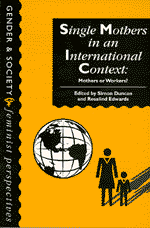

![]()
![]()

This book starts with a critique of traditional comparative studies which concentrate on national welfare regimes and policies. The editors argue that the causal model of policy is over-simplistic, and that it is a 'mechanistic understanding' of the behaviour of single mothers. For example, they argue that a change in the national policy such as providing universal affordable child care facilities does not necessarily lead to higher labour market participation of single mothers. They emphasise that social processes, informal structure, subjectivity and action by single mothers themselves are more important in determining whether they become mothers or workers. In this collection, Duncan and Edwards develop a 'multi-layered context action model' to understand the various dynamics and processes in which lone parents are positioned as mothers and workers, and the constraints they face in combining the two.
The chapters are presented in the order according to Esping-Andersen's scheme of welfare states, from the most liberal welfare regimes (Republic of Ireland) to the most developed welfare states (Sweden), alongside the continuum of home-based motherhood to work-based motherhood. In each chapter, opportunities and constraints of single mothers in taking up paid employment are examined at four contextual levels: dominant and alternative discourse, state welfare regimes and policies; gendered and stratified labour markets and neighbourhood resources and supports.
Whilst state welfare systems and policies and gender-segregated labour markets are already well-researched, the value of this edition lies in the diversity in the discourse, neighbourhood resources and support presented in each country. The diverse experiences of single mothers in these different welfare regimes are vividly described in each contribution, such as religion, social stigma, social network, neighbourhood acceptance and support as well as local labour market structures. This is particularly well illustrated by Klett-Davies in the former East and West Germany. The single mothers' own subjective perception of their roles as home-makers and bread-winners, the editors argue, plays an important part in the making of the mother-worker dilemma.
What is lacking from this edition is more explicit guidance on how to integrate the four contextual levels in the understanding of single mothers' dilemma. What, if tackling these issues at the national policy level is not the answer, will be more appropriate in helping single mothers' to combine their roles of home-makers and bread-winners? Having dismissed this approach as mechanistic and having stressed the importance of local characteristics and neighbourhood diversities, it is not clear how the understanding of these local characteristics and variability could be translated into policies at a local level.
The absence of a discussion of policy implications at a neighbourhood level in the afterword is rather disappointing. If neighbourhood support and resources are important in helping single mothers to combine their dual roles of mothers and workers, should this point to the need for formal recognition of informal child care arrangements by the government?
In contrast, the editors' conclusion points to changes at the national if not global level. They suggest that part-time employment is unlikely to lift lone parents out of the poverty trap in the sex-segregated and badly rewarded labour market. Unfortunately, lone parents are unlikely to benefit immediately from any long-term structural changes in the labour market, if this happens at all. The success of Australia's JET programme and the Swedish example of removing lone parents' poverty highlighted in the afterword again points to a need for changes in the direction of national policy, rather than policy recommendations at the neighbourhood level.
Nevertheless, this edition provides extensive materials of research on lone parents in an international context. The Japanese and German experiences are particularly interesting. And indeed the diversity of single mothers' experiences of mothers and workers at the neighbourhood level has added something new.
Sin Yi Cheung
Oxford Brookes University